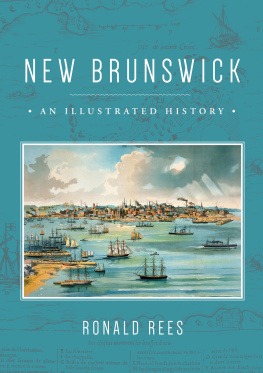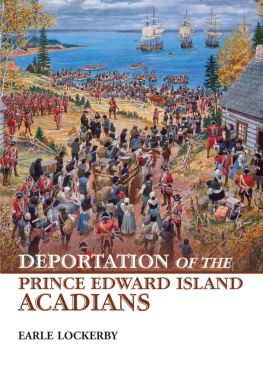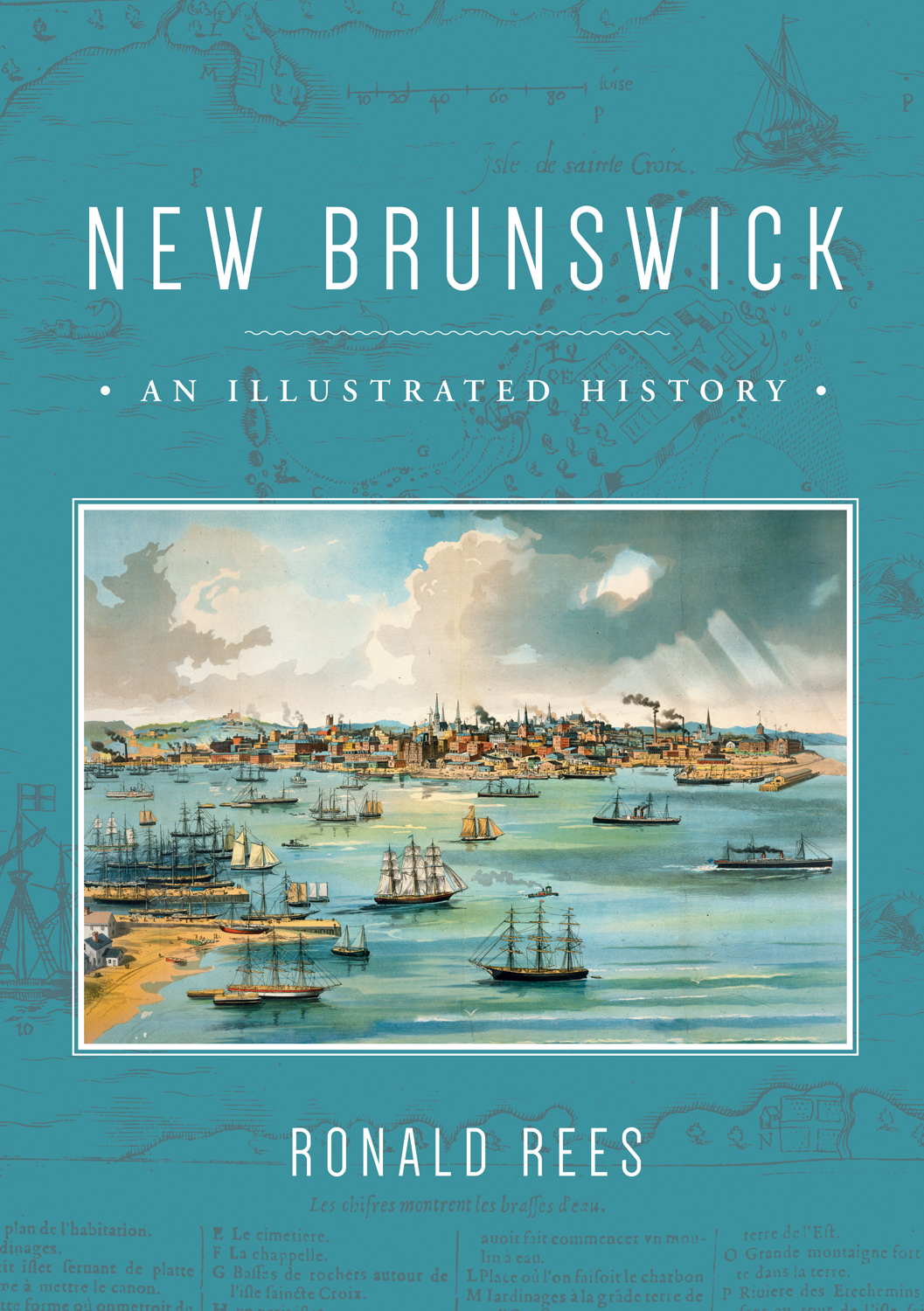Copyright 2014, Ronald Rees
All rights reserved. No part of this book may be reproduced, stored in a retrieval system or transmitted in any form or by any means without the prior written permission from the publisher, or, in the case of photocopying or other reprographic copying, permission from Access Copyright, 1 Yonge Street, Suite 1900, Toronto, Ontario, M5E 1E5.
Nimbus Publishing Limited
3731 Mackintosh St, Halifax, NS, B3K 5A5
(902) 455-4286 nimbus.ca
Printed and bound in Canada
NB1115
Design: John van der Woude Designs
Cover image: View of Saint John and harbour. Advertisement for Manchester, Robertson & Allison, dry goods merchants. Library and Archives Canada c-121133
Library and Archives Canada Cataloguing in Publication
Rees, Ronald, 1935-, author
New Brunswick : an illustrated history / Ronald Rees.
Includes bibliographical references and index.
Issued in print and electronic formats.
ISBN 978-1-77108-152-8 (pbk.).ISBN 978-1-77108-153-5 (pdf).
ISBN 978-1-77108-154-2 (mobi).ISBN 978-1-77108-155-9 (html)
1. New BrunswickHistoryPictorial works. I. Title.
FC2462.R43 2014 971.51030222 C2013-908118-6
C2013-908119-4
Nimbus Publishing acknowledges the financial support for its publishing activities from the Government of Canada through the Canada Book Fund ( CBF ) and the Canada Council for the Arts, and from the Province of Nova Scotia through Film & Creative Industries Nova Scotia. We are pleased to work in partnership with Film & Creative Industries Nova Scotia to develop and promote our creative industries for the benefit of all Nova Scotians.
ForRichard and Marlene Wilbur
Contents
Chapter Four - The Carrying Trade and the
International Boundary
Chapter Seven - Free Trade, Reciprocity,
and Confederation
Chapter Eight - The Intercolonial Railway
and the Landward Economy
Preface
A province of fewer than a million people on the eastern edge of a continent-sized country whose population and wealth is overwhelmingly concentrated in the middle and west can hardly claim primacy. Yet New Brunswicks history is significant and colourful. A small island near the mouth of the St. Croix River was the stage, in 1604, for the first European attempt at year-round settlement on the coast of the North Atlantic above Florida. Defeated by a savage winter, Champlains and Pierre Dugua de Monss French settlers were forced to move, but their descendants, strengthened by recruits from the home region in France, built successful farm settlements on marshlands at the head of the Bay of Fundy. An international war led to their destruction and a catastrophic, and now legendary, mass deportation.
A mass deportation in an opposite direction impelled the founding of the province. Uneasy about rule from distant Halifax, the fifteen thousand Loyalist refugees from the newly independent and unforgiving United States, who had chosen to settle on the north shore of the Bay of Fundy, petitioned London for a new colony separate from Nova Scotia. Once permission had been granted, they, and the New Englanders who preceded them and the French who had remained or returned, began to make liveable a forested wilderness inhabited by a few thousand Aboriginal people. Without roads, and with only small amounts of farmable land, they turned to the woods and the waters, cutting lumber, building ships, catching and processing fish, and selling these overseas. Their chief markets were imperial ones, in Britain and the West Indies. But as well as trading with their own products, they served as carriers for Americans who were denied access to imperial markets and as illicit go-betweens for British merchants who in times of hostile relations with the United States could not trade directly with them.
While Great Britain and America remained at odds with each other, and while colonial products enjoyed a favoured status in British markets, New Brunswick prospered. But it was an uncertain prosperity dealt a damaging blow by Britains embrace of free trade in the middle of the nineteenth century. Deprived of its role in the commerce of the Atlantic, New Brunswick found itself on the fringe of a continent increasingly preoccupied with the development of its own interior. Neglected by the mother country, it was forced to make new landward arrangements, and together with its Maritime neighbours it chose union (Confederation) with the former colonies of Upper and Lower Canada. The effect, as New Brunswick historian T. W. Acheson remarked, was the exchange of an overseas master for a land-based central Canadian one.
The markets were in central Canada, a thousand kilometres away, over a railway that was difficult and costly to maintain. With its staple industries stagnant or in decline, and new industries in competition with far more favourably placed ones in central Canada, the adjustments were trying and long. Farming, lumbering, fishing, and wooden shipbuilding had to be refashioned or replaced. A society and an economy that were in large part rural and sustained by handcrafts have become urban. Yesterdays shipwright is todays structural engineer, more than likely living in or around one of the larger southern towns or cities. As elsewhere, service industries and manufacturing are now the major employers. Recently, New Brunswicks population has shown signs of growth, and the provinces largest company has placed now hiring signs along one of the major highways. But celebration would be premature. The rate of population growth is only half the national average and without immigration, which is also below average, the population will likely decline. To balance its budget, the provincial government depends on federal government equalization payments for up to 40 per cent of its expenditures.
To distribute provincial resources more evenly, and reduce economic imbalances that had developed between the anglophone south and west and the largely francophone or Acadian north and east, required structural changes in government. The antiquated county system, created by the Loyalists in the image of eighteenth-century England, gave way in the middle of the last century to a more even-handed centralized one. The levelling also required a new language act, granting French the same official status as English. New Brunswick is now a bilingual province and Moncton, the provinces urban prodigy, the countrys first officially bilingual city.
As a narrative drawn almost entirely from published sources, this book is for general readers interested in the development of the province, not scholars and academics. The latter may turn to W. S. MacNutts magisterial New Brunswick: A History,1784-1867 based on the study of official documents housed in archives and libraries in London and Ottawa. It ends at Confederation, and at five hundred dense pages it might exceed the attentive powers of general readers. I have drawn shamelessly upon it. For the post-Confederation history, there are books on particular aspects of that history as well as a large number of articles, most of the latter in Acadiensis, a distinguished journal published by the University of New Brunswick. I have listed in a bibliography the published material I found most useful.
It may seem invidious to isolate a single book, but at times when I was uncertain about how to proceed without a comforting scaffolding of references and footnotes, I turned to Michael Collies New Brunswick. Collie was an English-born professor of English who, in the 1970s, wrote a guide to the province. His book is a captivating blend of observation of the present and reflection upon the past, a combination seldom found in non-fiction writing in Canada. It will be read, I think, when other more earnest efforts have been shelved. An author, as distinct from a specific work, whom I must also acknowledge is William Francis Ganong. Saint Johnborn Ganong lacked Collies literary gifts, but when not professing botany at Smith College in Massachusetts he combed the province, unearthing documents, recording folk memories, and enfolding these in writings that ranged from essays in scholarly journals, monographs and books, to dozens of articles in the humblest newspapers and magazines. Ganong was that rare combination, a scholar of great reach who was also the peoples historian.

















